高中英语必修一第一单元教案设计
- 格式:doc
- 大小:73.00 KB
- 文档页数:14
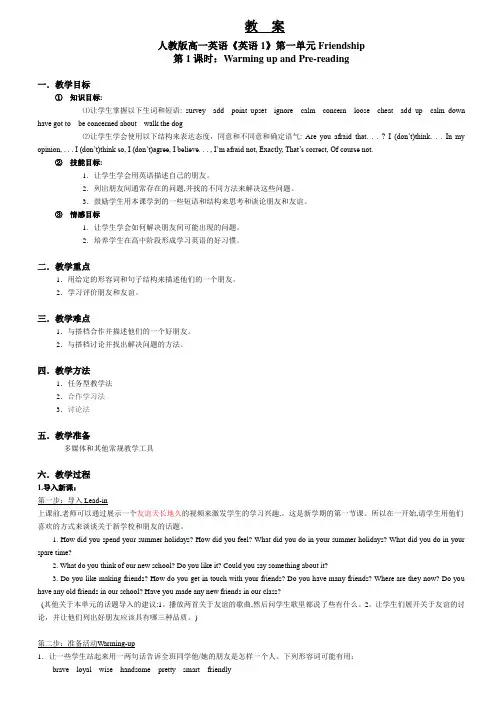
教案人教版高一英语《英语1》第一单元Friendship第1课时:Warming up and Pre-reading一.教学目标①知识目标:⑴让学生掌握以下生词和短语: survey add point upset ignore calm concern loose cheat add up calm down have got to be concerned about walk the dog⑵让学生学会使用以下结构来表达态度,同意和不同意和确定语气: Are you afraid that. . . ? I (don’t)think. . . In my opinion, . . . I (don’t)think so, I (don’t)agree, I believe. . . , I’m afraid not, Exactly, That’s correct, Of course not.②技能目标:1.让学生学会用英语描述自己的朋友。
2.列出朋友间通常存在的问题,并找的不同方法来解决这些问题。
3.鼓励学生用本课学到的一些短语和结构来思考和谈论朋友和友谊。
③情感目标1.让学生学会如何解决朋友间可能出现的问题。
2.培养学生在高中阶段形成学习英语的好习惯。
二.教学重点1.用给定的形容词和句子结构来描述他们的一个朋友。
2.学习评价朋友和友谊。
三.教学难点1.与搭档合作并描述他们的一个好朋友。
2.与搭档讨论并找出解决问题的方法。
四.教学方法1.任务型教学法2.合作学习法3.讨论法五.教学准备多媒体和其他常规教学工具六.教学过程1.导入新课:第一步:导入Lead-in上课前,老师可以通过展示一个友谊天长地久的视频来激发学生的学习兴趣,。
这是新学期的第一节课。
所以在一开始,请学生用他们喜欢的方式来谈谈关于新学校和朋友的话题。
1. How did you spend your summer holidays? How did you feel? What did you do in your summer holidays? What did you do in your spare time?2. What do you think of our new school? Do you like it? Could you say something about it?3. Do you like making friends? How do you get in touch with your friends? Do you have many friends? Where are they now? Do you have any old friends in our school? Have you made any new friends in our class?(其他关于本单元的话题导入的建议:1。
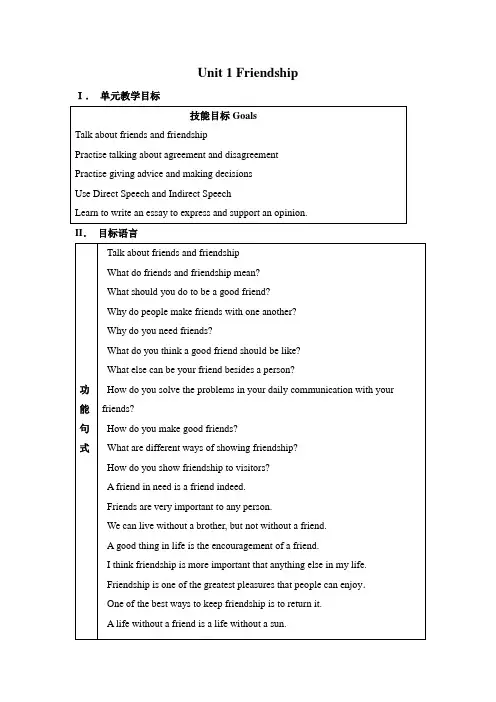
Unit 1 Friendship I.单元教学目标II.目标语言III. 教材分析和教材重组1. 教材分析本单元以Friend和Friendship为话题,旨在通过单元教学使学生通过讨论什么是好朋友,什么是真正的友谊,如何交友和保持友谊等问题,使学生树立正确的交友观。
并针对日常交友过程中经常遇到的实际问题,指导学生发表自己的见解和看法,通过进一步讨论提供有效的解决方案。
并能就此以编辑的身份写出指导信,对相关谚语写出观点明确、论证有力的短文。
1.1 Warming Up以调查问卷的形式,通过对学生在日常交友过程中所遇到的五个问题,展开调查,使学生对是否擅长交友做出评价,激发学生对本单元的中心话题产生兴趣;同时也使教师本单元的授课更具有针对性,从而有效地帮助学生树立正确的交友观。
1.2 Pre-Reading通过四个问题引导学生讨论交友的重要性以及自己心目中好朋友的概念和标准,并使学生认识到不仅人与人,人与物(如日记)也可以成为好朋友。
继续探究并树立正确交友观,并为阅读作好了准备。
1.3 Reading讲述第二次世界大战的纳粹统治时期,犹太人Anne一家过着滇沛流漓,与世隔绝的生活。
Anne在孤独中只能以日记Kitty 为友,倾诉衷肠,伴其渡过两年的逃亡生涯。
控诉了纳粹党的残暴统治给犹太人民带来了深重的灾难,并以日记的形式表达了以主人公Anne为代表的全世界人民憎恨战争渴望和平的共同心愿。
学生学习了新的词汇、句型,提高了阅读水平。
文中选用了主人公的一篇日记,使学生进一步感受到了挚友的可贵,对主人公内心世界的描写有了更深刻的理解。
1.4 Comprehension 设计了三种题型。
其中前两个是考查学生对READING文章细节内容的理解,最后一题是开放性问题,学生可以在更深入理解主人公内心世界的基础上各抒己见,使学生养成勤于思考勇于探究的良好的学习习惯,现时也培养了学生的想象力,进一步提高了阅读水平。
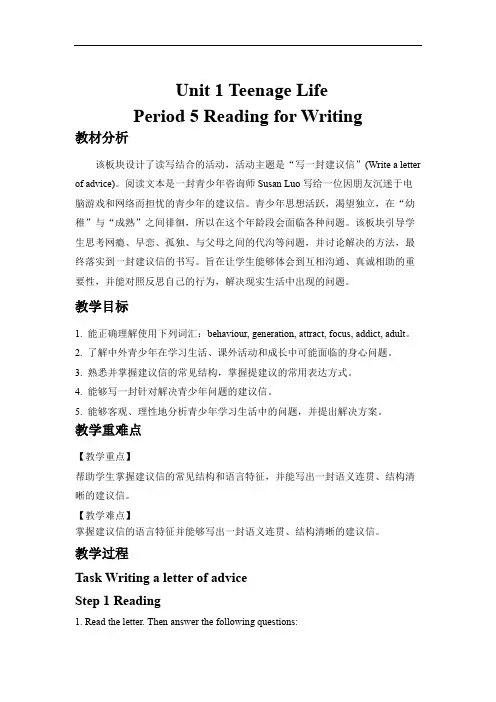
Unit 1 Teenage LifePeriod 5 Reading for Writing教材分析该板块设计了读写结合的活动,活动主题是“写一封建议信”(Write a letter of advice)。
阅读文本是一封青少年咨询师Susan Luo写给一位因朋友沉迷于电脑游戏和网络而担忧的青少年的建议信。
青少年思想活跃,渴望独立,在“幼稚”与“成熟”之间徘徊,所以在这个年龄段会面临各种问题。
该板块引导学生思考网瘾、早恋、孤独、与父母之间的代沟等问题,并讨论解决的方法,最终落实到一封建议信的书写。
旨在让学生能够体会到互相沟通、真诚相助的重要性,并能对照反思自己的行为,解决现实生活中出现的问题。
教学目标1. 能正确理解使用下列词汇:behaviour, generation, attract, focus, addict, adult。
2. 了解中外青少年在学习生活、课外活动和成长中可能面临的身心问题。
3. 熟悉并掌握建议信的常见结构,掌握提建议的常用表达方式。
4. 能够写一封针对解决青少年问题的建议信。
5. 能够客观、理性地分析青少年学习生活中的问题,并提出解决方案。
教学重难点【教学重点】帮助学生掌握建议信的常见结构和语言特征,并能写出一封语义连贯、结构清晰的建议信。
【教学难点】掌握建议信的语言特征并能够写出一封语义连贯、结构清晰的建议信。
教学过程Task Writing a letter of adviceStep 1 Reading1. Read the letter. Then answer the following questions:(1) What is Worried Friend’s problem?(2) What suggestions does Susan Luo give to Worried Friend?(3) Besides suggestions, what else does Susan Luo say in her letter?Step 2 Pre-writing2. Work on Activity 1. Students discuss the last 2 questions in groups.3. Work on Activity 2. Study the organisation and language features. Then summarize the expressions used to make suggestions.设计意图:该环节属于语言输入阶段,活动一关注阅读文本内容,活动二关注文本结构和语言特点。
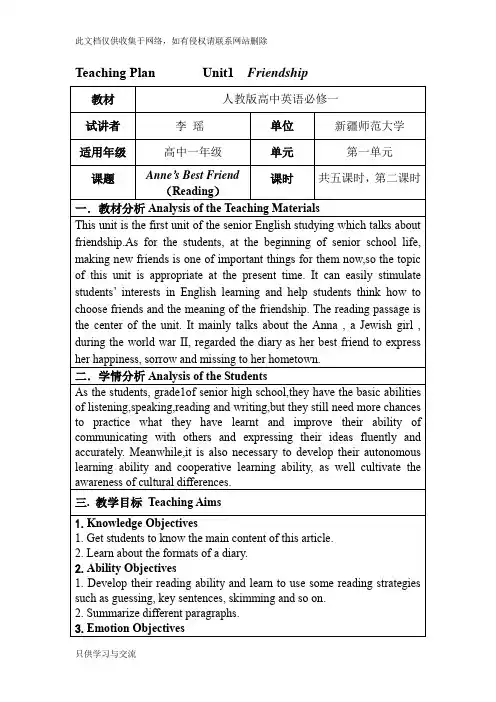

必修一第一单元单元教学内容分析
高中英语教学设计(一)
教学过程设计
附录
高中英语教学设计
教学过程设计
Blackboard Design
AFTERTHOUGHT
附录
高中英语教学设计
教学过程设计
Blackboard Design
Reflection After Teaching
附录
高中英语教学设计
教学过程设计(I)
(II)
Blackboard Design(板书设计)
Reflection After Teaching(教学反思)
高中英语教学设计
教学过程设计
附录
高中英语教学设计
教学过程设计
Blackboard Design(板书设计)
Reflection After Teaching(教学反思)
附录
昆明工务段火烧坝林务工区生产设施改造工程
施
工
组
织
设
计
编制单位:云南华田建筑工程有限公司编制人:
审核人:
编制日期:年月日。
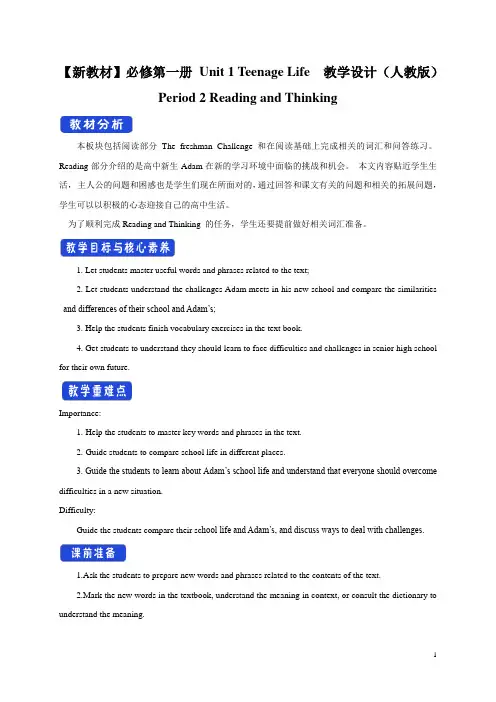
【新教材】必修第一册Unit 1 Teenage Life 教学设计(人教版)Period 2 Reading and Thinking本板块包括阅读部分The freshman Challenge 和在阅读基础上完成相关的词汇和问答练习。
Reading部分介绍的是高中新生Adam在新的学习环境中面临的挑战和机会。
本文内容贴近学生生活,主人公的问题和困惑也是学生们现在所面对的,通过回答和课文有关的问题和相关的拓展问题,学生可以以积极的心态迎接自己的高中生活。
为了顺利完成Reading and Thinking 的任务,学生还要提前做好相关词汇准备。
1. Let students master useful words and phrases related to the text;2. Let students understand the challenges Adam meets in his new school and compare the similarities and differences of their school and Adam’s;3. Help the students finish vocabulary exercises in the text book.4. Get students to understand they should learn to face difficulties and challenges in senior high school for their own future.Importance:1.Help the students to master key words and phrases in the text.2.Guide students to compare school life in different places.3. Guide the students to learn about Adam’s school life and understand that everyone should overcome difficulties in a new situation.Difficulty:Guide the students compare their sc hool life and Adam’s, and discuss ways to deal with challenges.1.Ask the students to prepare new words and phrases related to the contents of the text.2.Mark the new words in the textbook, understand the meaning in context, or consult the dictionary to understand the meaning.Step 1 Preparation1.freshman___________ junior high school ___________ Senior highschool___________confusing___________ choose courses___________ sign up___________extra-curricular activities___________hand out ___________ homeless people___________ in the community ___________ get used to doing___________ keep up with ___________2.challenge _________ topic________ fluent _________ graduate ________recommend ___________ literature_________ obviously _________quit_________be responsible for _________ schedule_________ editor_________Step 2 Warming upCompare school life in different placesActivity 11.Guide the students to take part in the group work and discuss school life in and out of China.Ask Ss to work in groups and discuss the questions.1)What do you want to know about the school life in other countries?Possible answers:I want to know whether they take extra courses during summer or winter vocations.I wonder if they have enough free time to develop their own interests.I am interested in what subjects they study at school.…2)What would you tell a teenager from another country about school life in China?I am happy to come to my new school and know a lot of new friends.Our teachers are patient and helpful.I feel a little worried about my study because I have more subjects to learn.…Activity 22.Read the text quickly to find the main idea of each paragraph.Guide the students to read the text quickly and fill in the blanks in this part.Possible answers:Paragraph1:Senior high school is a Challenge.Paragraph2:It is important to choose courses.Paragraph3:Extra-curricular activities are also important.Paragraph4:A senior high student must work harder and be more responsible.Step3 Intensive readingActivity 3Read the text again and answer the questions.Guide the students to read the text carefully and find the answers to the following questions.1.What causes did Adams choose? Which one do you think would be his favorite? Why?2.What does “make the team” in paragraph mean?3.What is Adam worried about?4.Is Adam confident that he will get used to senior school life? How do you know?Possible answers:1.Adam chooses Math, English chemistry, world history and Chinese. I think. English advancedliterature is his favorite because he likes English, and he is good at it.2.It means joining the football team.3.He is worried that he can’t keep up with other students in his advanced course and get used to allthe homework.4.Yes, he is. On the one hand, Adam knows that he has to study harder as a senior school studentto be well prepared for his future. On the other hand, Adam knows that school advisers andteacher can give him help when he is faced with problems.Activity 4Complete the outline. Then discuss the questions below with a partner.Get the students to work in pairs and fill in the blanks after discussing the questions carefully. Encourage the students to find clues from the text.Guide the students to discuss the following questions and encourage them to answer the questions according to Adam’s story and their own situation.1.What kind of person do you think Adam is? Why?2.Do you face the same challenges as Adams? What other challenges are you facing?3.What are some differences between Adam’s school and your school life?Possible answers:1.Adam is clear-minded and responsible for himself. When he chooses courses, he knows hisadvantages。
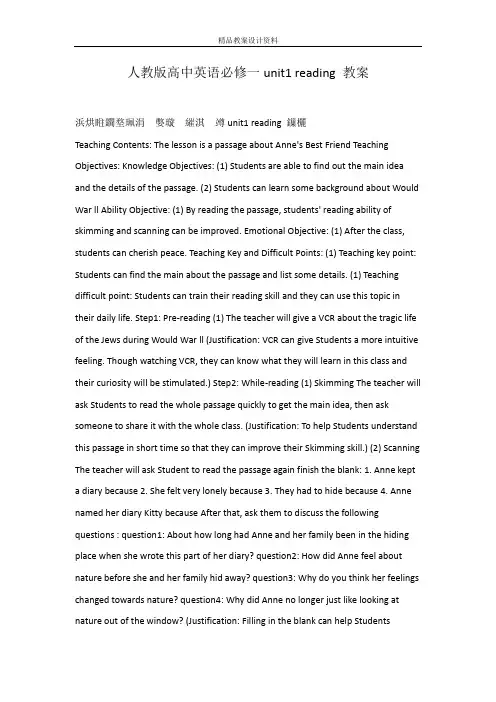
人教版高中英语必修一unit1 reading 教案unit1 readingTeaching Contents: The lesson is a passage about Anne's Best Friend Teaching Objectives: Knowledge Objectives: (1) Students are able to find out the main idea and the details of the passage. (2) Students can learn some background about Would War ll Ability Objective: (1) By reading the passage, students' reading ability of skimming and scanning can be improved. Emotional Objective: (1) After the class, students can cherish peace. Teaching Key and Difficult Points: (1) Teaching key point: Students can find the main about the passage and list some details. (1) Teaching difficult point: Students can train their reading skill and they can use this topic in their daily life. Step1: Pre-reading (1) The teacher will give a VCR about the tragic life of the Jews during Would War ll (Justification: VCR can give Students a more intuitive feeling. Though watching VCR, they can know what they will learn in this class and their curiosity will be stimulated.) Step2: While-reading (1) Skimming The teacher will ask Students to read the whole passage quickly to get the main idea, then ask someone to share it with the whole class. (Justification: To help Students understand this passage in short time so that they can improve their Skimming skill.) (2) Scanning The teacher will ask Student to read the passage again finish the blank: 1. Anne kept a diary because 2. She felt very lonely because 3. They had to hide because 4. Anne named her diary Kitty because After that, ask them to discuss the following questions : question1: About how long had Anne and her family been in the hiding place when she wrote this part of her diary? question2: How did Anne feel about nature before she and her family hid away? question3: Why do you think her feelings changed towards nature? question4: Why did Anne no longer just like looking at nature out of the window? (Justification: Filling in the blank can help Studentsunderstand the passage better. The discussion can not cultivate their cooperation sense but also stimulate their imagination.) Step3 : Post-reading (1) Retelling In this step, the teacher will invite two of them to narrate the passage in his or her own words standing on the platform. (Justification: Standing on the platform can give them much more confidence in expressing them. Narrating in their own words can train their concluding ability and deepen their impression of the content of this class. ) (2) Group Work Teacher give Students some questions: Imagine you have to go into hiding like Anne and her family. What would you miss most? Why? Add students can first dicuss them in groups, give their own opinions and choose a member to present their opinions to the whole class. (Justification: This step will pratice student's ability of speaking anf develop their spirit of cooperating with others.) Step4 : Summary and Homework Summary: The teacher summarizes what they have learnt in this class. Homework: Read the passage fluently and oay attention these important words. (Justification: Students can review and consolidate what they have learnt in this class. )。
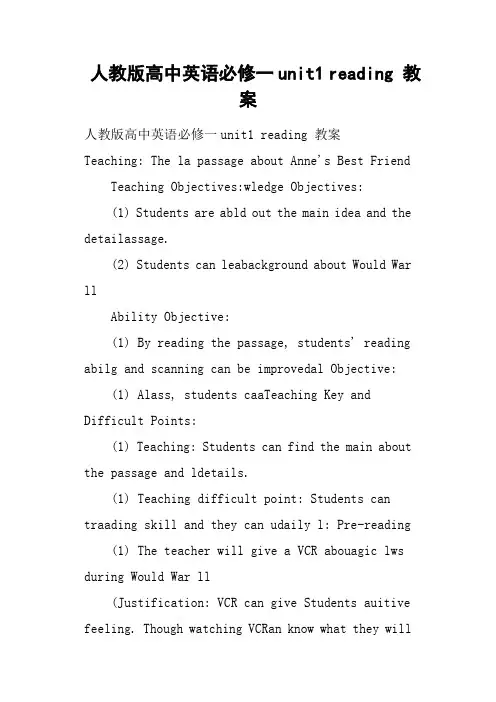
人教版高中英语必修一unit1 reading 教案人教版高中英语必修一unit1 reading 教案Teaching: The la passage about Anne's Best Friend Teaching Objectives:wledge Objectives:(1) Students are abld out the main idea and the detailassage.(2) Students can leabackground about Would War llAbility Objective:(1) By reading the passage, students' reading abilg and scanning can be improvedal Objective:(1) Alass, students caaTeaching Key andDifficult Points:(1) Teaching: Students can find the main about the passage and ldetails.(1) Teaching difficult point: Students can traading skill and they can udaily l: Pre-reading (1) The teacher will give a VCR abouagic lws during Would War ll(Justification: VCR can give Students auitive feeling. Though watching VCRan know what they willlealass anduwill be stimulated.)2: While-reading (1)gThe teacher will ask Studad the whole passage quickly to gain idea, then aare it wwholecla(Justification: To help Students understand this passagaan improvg skill.)(2) ScanningThe teacher will ask Studad the passage agablank:Aa diary becau2lt very lonely becauThey had to hide becauAnne named her diabecauAfter that, adiscullowing qu:question1: About how long had Anne and her family bding place wwadiary?question2: How did Anne feel about nature band her family hid away?question3: Why do youlings changed towards nature?question4: Why did Anne no longer just like looking at nature ouwindow?(Justification: Fillingblank can help Students understand the passage better. The discussion can not cultivaabut also stimulaagination.):Post-reading(1) RetellingIacher will invite twarraassagwn words standingla(Justification: Standinglatform can givudxpressing them. Narratingwn words can traluding ability and dlass. )(2) Group WTeacher give Studquestions: Imagine you have to gding like Anne and her family. What would you? Why? Add students cadicugroups, givwanda membwhole cla(Justification: Twill pratice student's abilaking anf develating w): Summary and Homewummary: The teacher summarizes whaave lealaHomework: Read the passage fluently and oay aant words.(Justification: Students can review and consolidate whaave lealass. )。

高中英语必修一Unit 1—教学设计【教学参考】Writing(书面表达)WritingTeaching aims1.Knowladge aimStudents can use proper words to write a passage2.Ability aimStudents can write a passage in a correct way3.Emotional aimStudents can express themselves properlyTeaching important and difficult pointHow to use proper words to write a passageTeaching methodTask-based learningTeaching aidsMulti-mediaTeaching proceduresStep 1 leading-inCheck the compositionStep 2 How to write a composition五个步骤1. 审题文字信息图画信息题材、人称、时态、要点2、按点择词:用一两个单词或短语写出每句话的细节要点3、联词成句:用联词成句的方法将上述要点的词语扩展成句子。
4、组句成文:①主语和谓语②背景(适当增加时间、地点等)③逻辑关系④开头与结尾⑤语篇连接常用连词●强调—after all, still, indeed, of course, above all, surely, certainly, in any case, anyway, above all, in fact, especially, obviously, clearly.●比较—in the same way, equally●对比—on the other hand, on the contrary, however, while,whereas, instead, but, nevertheless, otherwise●列举—for example, such as, for instance, take…for example, except (for)●时间—recently, nowadays, lately, then, later, next, finally, at last, in the end, soon, eventually, meanwhile, from now on, at the same time, for the time being, immediately, now and then, as soon as, afterwards●顺序—first, second, third, then, finally, to begin with, first of all, in the first place, last, next, above all, last but not the least, first and most important●可能—probably, perhaps●解释—in other words, in fact, as a matter of fact, that is, namely●递进—what’s more, in addition, besides, moreover●让步—even if, even though, although, after all, in spite of, despite, though, whatever may happen●转折—but, however, rather than, instead of, yet, on the other hand, unfortunately, whereas●原因—because, for this reason, due to, thanks to, because of, as, since, owing to●结果—as a result, so, therefore, as a consequence●总结—on the whole, in a word, in brief, in short5、检查、修改、润色,规范书写Step 3 How to polish your compositionTask1. Compare the following sentences1. I didn’t realize I was wrong until you told me.Not until you told me did I realize I was wrong.It was not until you told me that I realized I was wrong.2. The old man led the way and we had no trouble finding the house.With the old man leading the way, we had no trouble finding the house.Task2 How do you polish the following sentences?1、Mike is very you ng . He can’t move the heavy box.2、If you think hard, you will answer it.3、My mother didn’t agree with me and my father didn’t either.4、He won’t come, I think.5、Eating too much is not good.6、I don’t know where I shall go for my holidays.7、WangHai left the classroom after he closed all the windows.8、I was about to leave my house. The phone rang.9、I accept that he is not perfect. I do actually like theperson.10、Though you are clever,never offer to teach fish to swim.11、The earth is round. This is known to all.12、If he is given time, he’ll make a first-class tennis player.13、Students can act as mediators between people of different cultures. They have studied abroad.14、They are far away from their homeland. They feel lonely and homesick.Step 4 Writing面对中学生的“出国热”,社会对此不同的看法。
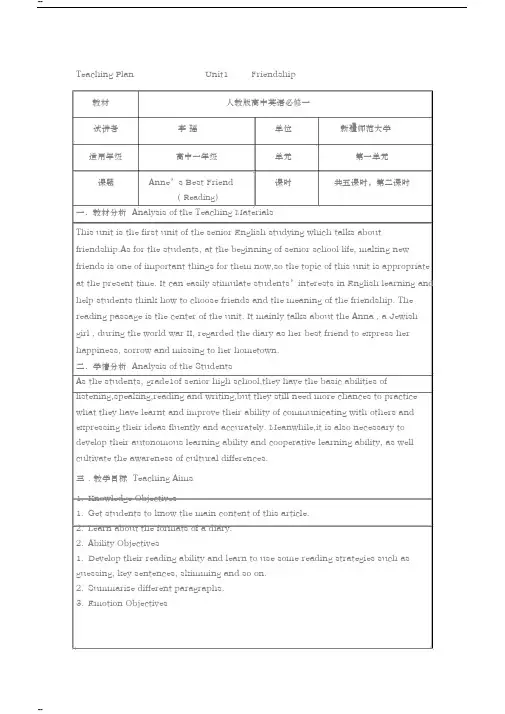

【英语】新人教版必修一 Unit1 示范教案Teaching planUnit oneTeaching aims:1. 能力目标:①Listening: gain useful information and clear views from the listening material;②Speaking: express one’s attitude or views about friends and friendship in appropriate words.③Reading: let Ss summarize the main idea④Writing: write a letter about how to make friends2. 知识目标:①Talk about friends and friendship; how to BE friends; how to gain friendship②Use the following expression:so do I / neither do II think it is a good ideaAll rightYes,but…③to get the Ss to master direct speech and indirect speech④vocabulary and phrases: upset, calm, concern, careless, loose, cheat, list, share, German, series, outdoors, crazy, purpose, thunder, entirely, power, trust, suffer, teenager, advice, quiz, editor, communicate, situation, add up, calm down, have got to, be concerned about, walk the dog, go through, hide away, set down, a series of, on purpose, so as to, face to face, according to, get along with, fall in love with, join in, be upset about, for once3. 情感目标:①To ari se Ss’ interest in learning English;②To encourage Ss to take part in the activities and make Ss confident;③To develop the ability to cooperate and communicate with others.4. 策略目标:①To develop Ss’ cognitive strategy: making notes when listening carefully;②To develop and improve Ss’ communicative strategies.5. 文化目标:To enable the Ss to come to know different opinions about making friends from different countries.6. 现实目标①To make Ss respect each other and friendship②To make them get well with one another in societyTeaching steps:Period oneStep 1. warming up1. Ss listen to an English song AULD LANG SYNE.2. Brainstorming: let Ss say some words about friendship:careful, warm-hearted, honest, friendly, brave, humorous, funny, smart, kind, open-minded, responsible….3. To let Ss make a correct choice about their questions that they meet in warming up.Step 2. practice speaking1. Ss talk about their old friends in Junior Middle School, talk about theirappearance, personality, hobbies, etc.2. Self-introduction or work in pairs3. Ss can ask some questions about life or learningStep 3. Make new friends1. Ss go around and ask their new friends some information and fill in the following form name age/hobbies/favorite sport s, books …2. Report to the class: who will probably be your friend why.Step 4. Do a surveySs do the survey in the text on P1Step 5. Listening and talkingDo Workbook on P41 (Talking). While Ss listen to the material, ask them to take notes about t he speaker’s views of making friends.When Ss make their conversation, ask them to try to use the following expressions.I am afraid not exactly I agree I think that is a good idea of course notStep 6. DiscussionDivide Ss four in one group and each group choose a topic to discuss. There are four topics.Topic 1: Why do you need friends? Make a list of reasons why friends are important to you.Topic 2: There is a saying “to have a good friend, you need to be a good friend.” What do you think of the saying and how can you be a good friend?Topic 3: Does a friend always have to be a person? What else can be your friend? Why?Topic 4: List some qualities of a person who does not make friend easily.Step 7. Summary1. Ask Ss themselves to summarize what is friendship and what is the most important in making friends.2. T shows more information about friendship and a poem about friendship.What is friendship?I want to find the answer to the questionWhat is friendship?When it rains, I think friendship is a small umbrella.It can give me a piece of clear sky.When I’m crying, I think friendship is a white handkerchief.It can wipe my tears dry.When I am sad, I think friendship is a warm word.It can bring me happiness again.When I am in trouble, I think friendship is a strong hand.It can help me escape my troubles.When I sit in a quiet place, I think friendship is a very wonderful feeling.It can’t be pulled and torn, because it is in everyone’s heart.It is there from the beginning to the end of our lives.3. Tell Ss: make new friends and keep the old; one is silver and the other is gold.Step 8. EvaluationSs finish the following evaluation form. Standard: A, B, CContents 自评他评1. I’m active in talking with others.2. I’m active in cooperating with others.3. I can express myself fluently, accurately and appropriately.4. I know more about friendship after the lesson…5. Do you think you need to improve yourself in some ways? Which ways?Homework:1. Look up the new words and expressions in warm-up and pre-reading in a dictionary.2. Write a short passage about your best friend.Period twoStep 1. Warming upActivity 1: Suppose you have to stay indoors to hide yourself for a whole year. You can never go outdoors, otherwise you will be killed. You have no telephone, computer, or TV at home.How would you feel?What would you do?Four students a group discuss with each other for 2 minutes.Activity 2: Play a short part of the moviesStep 2. PredictingStudents read the title of the passage and observe the pictures and the outline of it to guess:Who is Anne’s best friend?What will happen in the passage?Step 3. SkimmingStudents skim the passage in 2 minutes to get the main idea:Who is Anne’s best friend?When did the story happen?Step 4. ScanningStudents work in pairs to find the information required below:Anne in World War ⅡStep 5. Intensive readingStudents work in groups of four to discuss the following open questions:1. Why did the windows stay closed?2. How did Anne feel?3. What do you think of Anne?4. Guess the meanings of “spellbound”, “hold me entirely in their power”from the discourse(语篇,上下文).5. Which sentences attract you in the passage?Step 6. ActivityFour students a group to discuss the situation:Suppose you four have to hide yourselves for 3 months. During the three months, you will be offered the basic food, water and clothes. Your group can take 5 things with you.What will you take? Why?How will you spend the 3 months?How will you treat each other and make friends?Step 7. AssignmentTask 1. Surf the internet to find Anne’s Diary and read some of it. Print out a piece of the diary and write down your feelings after reading it on the page. We will share the pieces and your feelings with the whole class.Task 2.Ex 2.3 on Page3Period threeStep 1. Warming upCheck the Ss’ assignment: task 2Step 2. Language points:1. add (v.)1). To put together with something else so as to increase the number, size, importance, etc.增加,添加Please add something to what I’ve said, John.2). To join numbers, amount, etc so as to find the total 相加Add up these figures for me, please.add to something: to increase 增加The bad whether added to our difficultiesadd up to总计、加起来共是Having a big breakfast adds up to 112add…to…把…加到…Please add the names to your list2. Cheat v.1). To act in a dishonest way in order to win 欺骗;作弊2). (of, out of) to take from (someone) in a dishonest way 骗取The boss has cheated out of his money1). an act of cheating 作弊行为2). one who cheats 骗子3. Go through1).To examine carefully 仔细阅读或研究I went through the students’ papers last night.2).To experience 经历,遭受They went through the terrible earthquake at night4. Crazy (adj.)1). mad, foolish 疯狂的,愚蠢的It’s crazy to go out in such hot weather.2). wildly excited; very interested 狂热的,着迷的She is crazy about music5. Lonely (adj.) unhappy because of being alone or without friends 孤独的,寂寞的He has been very lonely since his wife left him.Lonely/alonealone1). without or separated from others单独的She lives alone.2). only 仅仅,只有。
高中英语必修一教案第一章:Unit 1 Life and Learning1.1 Teaching objectives:Students are able to understand and use the vocabulary related to school subjects and dly activities.Students can read and prehend the mn idea of a text about school life.Students can practice listening and speaking skills through group discussions and role-plays.1.2 Teaching procedures:1.3 Classroom activities:Warm-up: Ask students questions about their school life and dly activities.Introduce the topic of school life and show the picture related to the unit.Reading: Ask students to read the text and answer some questions to check their understanding.Listening: Play the audio and ask students to plete the exercises.Speaking: Divide students into groups and ask them to discuss their school life and dly activities.Summary: Review the mn idea of the unit and the vocabularyChapter Two: Unit 2 Myths and Legends2.1 Teaching objectives:Students can understand and use the vocabulary related to myths and legends.Students can read and prehend the mn idea of a text about a myth or legend.Students can practice listening and speaking skills through group discussions and presentations.2.2 Teaching procedures:2.3 Classroom activities:Warm-up: Ask students questions about their knowledge of myths and legends.Introduce the topic of myths and legends and show the picture related to the unit.Reading: Ask students to read the text and answer some questions to check their understanding.Listening: Play the audio and ask students to plete the exercises.Speaking: Divide students into groups and ask them to choose a myth or legend and present it to the class.Summary: Review the mn idea of the unit and the vocabularyChapter Three: Unit 3 Science and Technology3.1 Teaching objectives:Students can understand and use the vocabulary related to science and technology.Students can read and prehend the mn idea of a text about a scientific discovery or technological innovation.Students can practice listening and speaking skills through group discussions and presentations.3.2 Teaching procedures:3.3 Classroom activities:Warm-up: Ask students questions about their knowledge of science and technology.Introduce the topic of science and technology and show the picture related to the unit.Reading: Ask students to read the text and answer some questions to check their understanding.Listening: Play the audio and ask students to plete the exercises.Speaking: Divide students into groups and ask them to choose a scientific discovery or technological innovation and present it to the class.used.Chapter Four: Unit 4 The Environment4.1 Teaching objectives:Students can understand and use the vocabulary related to the environment.Students can read and prehend the mn idea of a text about environmental issues.Students can practice listening and speaking skills through group discussions and presentations.4.2 Teaching procedures:4.3 Classroom activities:Warm-up: Ask students questions about their knowledge of environmental issues.Introduce the topic of the environment and show the picture related to the unit.Reading: Ask students to read the text and answer some questions to check their understanding.Listening: Play the audio and ask students to plete the exercises.Speaking: Divide students into groups and ask them to choose an environmental issue and present it to the class.used.Chapter Five: Unit 5 Freedom and Responsibility5.1 Teaching objectives:Students can understand and use the vocabulary related to freedom and responsibility.Students can read and prehend the mn idea of a text about the importance of freedom and responsibility.Students can practice listening and speaking skills through group discussions and presentations.5.2 Teaching procedures:5.3 Classroom activities:Warm-up: Ask students questions about their understanding of freedom and responsibility.Introduce the topic of freedom and responsibility and show the picture related to the unit.Reading: Ask students to read the text and answer some questions to check their understanding.Listening: Play the audio and ask students to plete the exercises.Speaking: Divide students into groups and ask them to discuss the importance of freedom and responsibility in their lives.used.Chapter Six: Unit 6 Culture and Globalization6.1 Teaching objectives:Students can understand and use the vocabulary related to culture and globalization.Students can read and prehend the mn idea of a text about cultural exchange and globalization.Students can practice listening and speaking skills through group discussions and presentations.6.2 Teaching procedures:6.3 Classroom activities:Warm-up: Ask students questions about their knowledge of different cultures and globalization.Introduce the topic of culture and globalization and show the picture related to the unit.Reading: Ask students to read the text and answer some questions to check their understanding.Listening: Play the audio and ask students to plete the exercises.Speaking: Divide students into groups and ask them to research a cultural exchange program and present it to theclass.Summary: Review the mn idea of the unit and the vocabulary used.Chapter Seven: Unit 7 Australia7.1 Teaching objectives:Students can understand and use the vocabulary related to Australia.Students can read and prehend the mn idea of a text about Australia.Students can practice listening and speaking skills through group discussions and presentations.7.2 Teaching procedures:7.3 Classroom activities:Warm-up: Ask students questions about their knowledge of Australia.Introduce the topic of Australia and show the picture related to the unit.Reading: Ask students to read the text and answer some questions to check their understanding.Listening: Play the audio and ask students to plete the exercises.Speaking: Divide students into groups and ask them topresent information about a specific region or landmark in Australia.Summary: Review the mn idea of the unit and the vocabulary used.Chapter Eight: Unit 8 Sports8.1 Teaching objectives:Students can understand and use the vocabulary related to sports.Students can read and prehend the mn idea of a text about sports.Students can practice listening and speaking skills through group discussions and presentations.8.2 Teaching procedures:8.3 Classroom activities:Warm-up: Ask students questions about their favorite sports and teams.Introduce the topic of sports and show the picture related to the unit.Reading: Ask students to read the text and answer some questions to check their understanding.Listening: Play the audio and ask students to plete the exercises.present information about a specific sport or athlete. Summary: Review the mn idea of the unit and the vocabulary used.Chapter Nine: Unit 9 Heroes9.1 Teaching objectives:Students can understand and use the vocabulary related to heroes.Students can read and prehend the mn idea of a text about heroes.Students can practice listening and speaking skills through group discussions and presentations.9.2 Teaching procedures:9.3 Classroom activities:Warm-up: Ask students questions about their definition of a hero and examples they know.Introduce the topic of heroes and show the picture related to the unit.Reading: Ask students to read the text and answer some questions to check their understanding.Listening: Play the audio and ask students to plete the exercises.present information about a specific hero or heroine. Summary: Review the mn idea of the unit and the vocabulary used.Chapter Ten: Unit 10 The World of Work10.1 Teaching objectives:Students can understand and use the vocabulary related to the world of work.Students can read and prehend the mn idea of a text about different careers and the world of work.Students can practice listening and speaking skills through group discussions and presentations.10.2 Teaching procedures:10.3 Classroom activities:Warm-up: Ask students questions about their career aspirations and what they want to be when they grow up. Introduce the topic of the world of work and show the picture related to the unit.Reading: Ask students to read the text and answer some questions to check their understanding.Listening: Play the audio and ask students to plete the exercises.Speaking: Divide students into groups and ask them to research a specific career and present it to the class. Summary: Review the mn idea of the unit and the vocabulary used.Remember to adapt the activities to the specific needs and level of your students.重点和难点解析1. 教学目标的设计:在制定教学目标时,应确保它们具有可衡量的标准,以便在课程结束后能够评估学生是否达到了这些目标。
高一英语必修一unit1教案教案标题:Unit 1: Friendship教学目标:1. 了解和理解课文中的重点词汇和短语,如:acquaintance, bond, loyalty, betray, etc.2. 能够理解并运用课文中的重要句型和语法结构,如:used to, be/get used to, prefer, etc.3. 培养学生的阅读理解能力,能够从课文中获取关键信息并回答问题。
4. 培养学生的口语表达能力,能够用英语描述和讨论友谊的重要性和特点。
5. 提高学生的写作能力,能够撰写一篇关于友谊的短文。
教学重点:1. 课文中的重点词汇和短语。
2. 课文中的重要句型和语法结构。
3. 阅读理解能力的培养。
4. 口语表达能力的提高。
5. 写作能力的培养。
教学准备:1. 教材:高中英语必修一教材Unit 1。
2. 多媒体设备:投影仪、电脑等。
3. 教学素材:课文、课文相关的图片、课后练习题等。
教学过程:Step 1: 导入新课1. 利用一些图片或视频引导学生讨论友谊的重要性和特点。
2. 引入本单元的话题,并导入本单元的课文。
Step 2: 阅读理解1. 学生独立阅读课文,并回答与课文内容相关的问题。
2. 学生小组讨论并分享他们的答案。
3. 教师澄清学生可能存在的问题,帮助他们更好地理解课文。
Step 3: 词汇和语法学习1. 教师引导学生学习本单元的重点词汇和短语,包括释义、用法和例句。
2. 教师讲解本单元的重要句型和语法结构,并提供相关的例句和练习。
Step 4: 口语表达1. 学生分组讨论和描述他们对友谊的看法和经历。
2. 学生进行角色扮演,模拟真实的友谊场景,并展示他们的口语表达能力。
Step 5: 写作训练1. 学生根据课文内容和自己的理解撰写一篇关于友谊的短文。
2. 学生互相交换作文,并进行互评和修改。
Step 6: 总结和反思1. 教师帮助学生总结本节课的重点内容和学习收获。
Unit 1 Friendship Part One: Teaching Design Period 1: A sample lesson plan for reading (ANNE’S BEST FRIEND) Aims To talk about friendship To read about friendship Procedures I. Warming up 1. Warming up by assessing A lot of people have only few possibilities of getting feedback about their own personality. In this exercise you will have the opportunity to get some feedback and to discuss it with a partner. While comparing your mutual judgements, certain prejudices or misunderstandings may appear, as people often do not know each other thoroughly enough to judge others correctly. Try to be honest! Self assessment Of the following characteristics choose 5 that are particularly applicable to you personally. sociable, honest, friendly, easygoing, nervous, open-minded, anxious, careful, talented, talkative, nosy, thoughtful, generous, carefree, pessimistic, peaceful, optimistic, interesting, reliable, helpful, active, careless, caring, exact, adventurous, imaginative, hot-blooded, well-organised, trustworthy, patient, responsible, outgoing, kind, brave, warm-hearted, selfless, tolerant
Partner assessment Now choose 5 characteristic features which you think are especially applicable to your partner. sociable, honest, friendly, easygoing, nervous, open-minded, anxious, careful, talented, talkative, nosy, thoughtful, generous, carefree, pessimistic, peaceful, optimistic, interesting, reliable, helpful, active, careless, caring, exact, adventurous, imaginative, hot-blooded, well-organised, trustworthy, patient, responsible, outgoing, kind, brave, warm-hearted, selfless, tolerant 2. Warming up by describing Have the students get into groups of four to describe their own ideal friend. Individual students must decide on TOP 5 character adjectives that could be used to describe the ideal friend and insist they have good reasons for their choice. Then let the group leader give the class a description of their ideal friend. 3. Further applying You may also have the students do the survey in the textbook, following the steps below. 1. Get the students to make a list of three qualities a good friend should have. 2. Have the students get into groups of four to find out what each has listed. 3. Have a member of each group report on what their lists have in common and list them on the board. 4. Ask the class whether or not they agree with all the qualities listed. 5. Then have the students do the survey in the textbook. 6. Have the students score their survey according to the scoring sheet on page 8. 7. The teacher ask some students how many points they got for the survey and assess their values of friendship: ★ 4~7 points: You are not a good friend. You either neglect your friend’s needs or just do what he/she wants you to do. You should think more about what a good friend needs to do. ★ 8~12 points: You are a good friend but you sometimes let your friendship become too important, or you fail to show enough concern for your friend’s needs and feelings. Try to strike a balance between your friend’s needs and your own responsibilities. ★ 13+ points: You are an excellent friend who recognizes that to be a good friend you need balance your needs and your friend’s. Well done. (You may also show your students the results above and let themselves self-reflect upon their own values of friendship) II. Pre-reading To focus the Students’ attention on the main topic of the reading passage. To activate their previous knowledge on the topic. III. Talking and sharing Work in groups of four. Tell your group mates how you reflect on these questions. 1. Why do you need friends? Make a list of reasons why friends are important to you. 2. What do you think a good friend should be like? List what a good friend should do and share the list with your partners. 3. Does a friend always have to be a person? What else can be a friend? 4. Do you think a diary can become your friend? Why or why not? Instructions: The teacher can give each group one of these questions above to talk about. Then let the class share their ideas. It’s better to stimulate the students to challenge their classmates’ opinions about these questions. IV. Reading 1. Looking and guessing